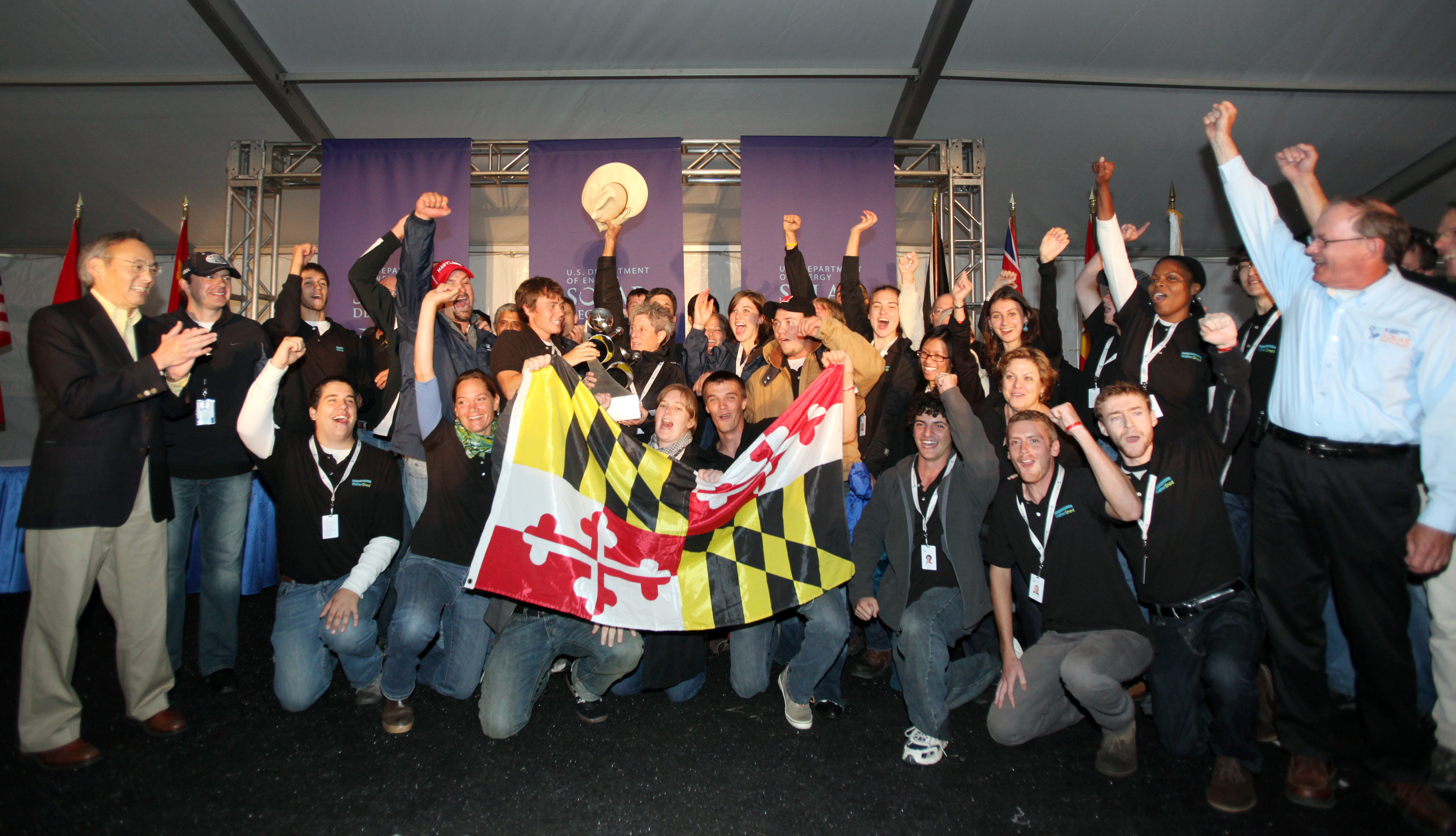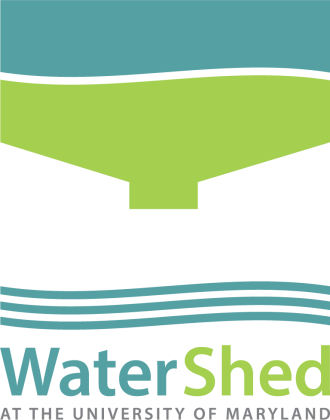
University of Maryland celebrates after winning the U.S. Department of Energy Solar Decathlon 2011
Credit: Stefano Paltera/U.S. Department of Energy Solar Decathlon
WaterShed has taken first place at the U.S. Department of Energy Solar Decathlon 2011. The announcement was delivered by US Energy Secretary Steven Chu Saturday afternoon in front of a packed tent of students, sponsors and supporters.
“There are lots of tears of joy and relief,” said Architecture Team Leader Leah Davies. “We are all so proud of the thought and hard work put into WaterShed, and really excited that our message was viewed in such a positive way.”
Consistently leading the pack throughout the competition, WaterShed finished with a 20 point lead over the second place winner, Purdue. New Zealand’s entry, First Light, came in third.
The student and faculty-built home, which blends solar energy efficiency and water conservation, was recognized by the jury for its beauty, its sustainability message through design and “impeccable” performance in measured contests.
“The innovation, creativity, skill, vision, cooperation, determination, and, yes, energy displayed by this team is both remarkable and a joy,” says University of Maryland President Wallace Loh. “I couldn’t be more proud of their work and accomplishment. These students, faculty and mentors have dedicated themselves to addressing critical needs of Maryland, the nation, and other countries. They’re the perfect example of what a public research university is all about.”
The Terps performed strongly throughout this year’s Decathlon, including a second place win in the final competition- market appeal- which was announced just before the overall winner today.
Late Friday evening the team received a perfect score of 100 in the energy balance competition – a measure of WaterShed’s energy efficiency – solidifying their lead going into the final day of scoring. In Friday’s Communication Competition, the Terps came in third behind Middlebury and Appalachian State. The jury noted Maryland’s “consistent messaging, strong educational exhibit components, and a compelling story.”
Earlier in the week, the Terps won the Architecture Competition. “WaterShed achieves an elegant mix of inspiration, function, and simplicity,” reported Architecture Juror Michelle Kaufman. “It takes our current greatest challenges in the built environment – energy and water – and transforms them into opportunities for spatial beauty and poetry while maintaining livability in every square inch.”
Panels of experts judge the competing entries on ten dimensions: their architectural qualities, market appeal, engineering, educational/communication effort, affordability, “comfort zone,” hot water systems, appliances, home entertainment and energy balance.
The international competition challenges 20 finalist collegiate teams to design, build, and operate solar-powered houses that are cost-effective, energy-efficient, and attractive. The Maryland team – the only finalist from the state and the Washington, D.C. area – is led by the University’s students, faculty and professional mentors.
“These students from diverse disciplines effectively formed a cohesive team to imagine, invent, and make real the project we call WaterShed,” says the project’s principal investigator Amy Gardner, an associate professor of architecture at the University Maryland. “Interdisciplinary problem solving is the way forward towards a more sustainable future.”
Inspired by the Chesapeake Bay, the power of WaterShed’s design comes from its twin focus on efficient, renewable energy and water quality and conservation, Gardner adds. It harvests, recycles and reuses water, while harmonizing modernity, tradition, and simple building strategies. The house balances time-tested best practices and advanced technological solutions to achieve high efficiency performance in an affordable manner.
WaterShed integrates a unique array of sustainable features, including.
- Split-butterfly roof, well-suited to capture and use both sunlight and rainwater;
- Constructed wetlands that filter stormwater and greywater (household water with limited contaminants);
- Green roof to retain rainwater and promote efficient cooling;
- Photovoltaic array to harvest enough solar energy to power WaterShed year-round;
- Solar thermal array to fulfill all domestic hot water needs;
- “Edible landscapes” that support community-based agriculture;
- Patent-pending indoor, liquid desiccant waterfall for high-efficiency humidity control;
- Efficient, cost-effective, durable and time-tested structural system.
“Taken together, these design features make WaterShed less thirsty for fossil fuels than standard homes and less dependent on costly water purifying infrastructure,” explain team members Allison Wilson and Leah Davies. “The house acts as a micro-ecosystem that encourages residents to live a more sustainable lifestyle – not only by conserving but also by capturing and reusing natural resources.”
University of Maryland President Wallace Loh describes WaterShed as “a model for how to live in harmony with the complex ecosystem of the largest estuary in the United States.” The project, he adds, “fulfills the mission of a 21st century Land Grant University by applying intellectual resources to make “a real-life impact” – in this case, “contributing to sustainability.”
Maryland Congressman Roscoe Bartlett and Rep. Chris Van Hollen, both members of the House Renewable Energy and Energy Efficiency Caucus, visited all 20 houses in the Solar Village on the opening day of the competition.
“The entries are more impressive every year in the Solar Decathlon, but with WaterShed the University of Maryland once again sets the bar high for all other competitors,” Bartlett said in a statement. “As an alum, that makes me so proud. Inspired by our own Chesapeake Bay, WaterShed is a stunningly beautiful, remarkably comfortable home with ingenious design, technology and engineering details that harness energy from the sun and water from rain in harmony with our environment. I am confident that it will be very difficult for any other house to match the combination of beauty and functionality of WaterShed by the University of Maryland on the ten elements of the Solar Decathlon 2011 competition.”
The Team Maryland involves students and faculty from the Maryland School of Architecture, Planning and Preservation, the A. James Clark School of Engineering, the College of Computer, Mathematical, and Natural Sciences, the University Libraries, and the School of Agriculture and Natural Resources. Maryland businesses and professional groups are providing significant support as well.

What did they win?
They got a nice trophy and bragging rights.
They got a nice trophy and bragging rights.
Great story about this event on the ‘Think Green’ show on http://www.myMCmedia.org